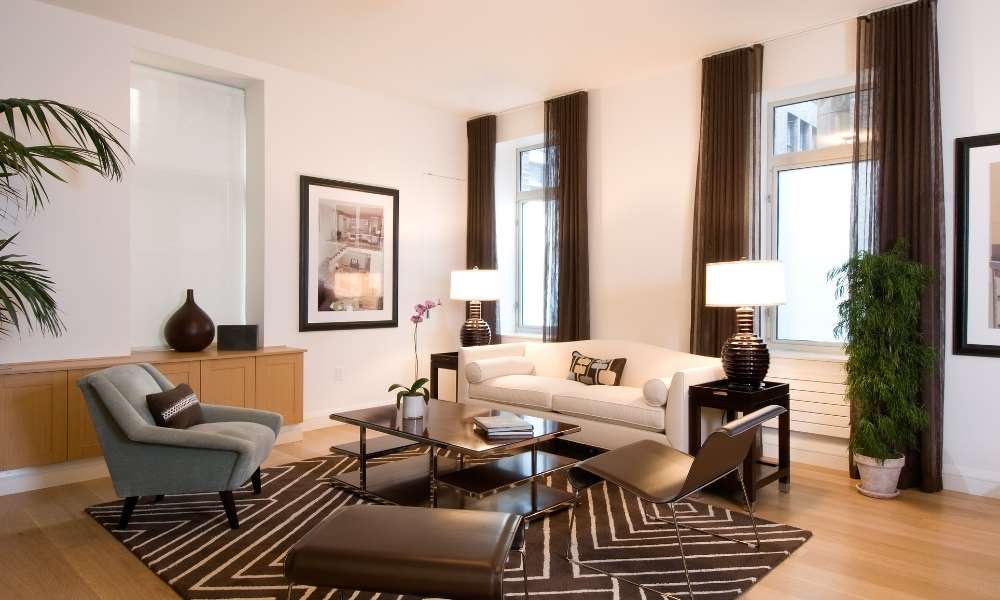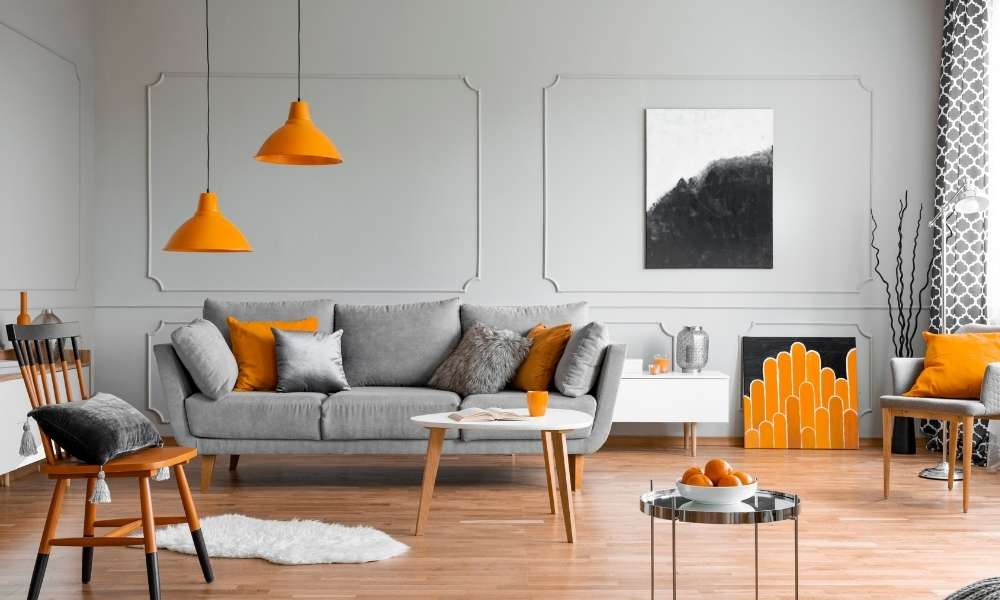Homeowners often ponder color schemes for their living space. The colors they choose can say a lot about the mood they are trying to create in the room, or it can just be a way to add personality to the space. Some colors can be associated with certain feelings such as warm colors like red and yellow giving off a cozy feeling. What color should I paint my living room? However, before picking a color, you should know more about how each different color will affect your surroundings.
The Colors That are Most Popular for Living Rooms
Warm colors are most popular among homeowners when it comes to living rooms. These colors include browns, yellows, and oranges. These colors give off a cozy feeling that is perfect for a living room. The color red also falls into this category due to its association with warmth.
People who want to create an energetic feel in their space often choose cool colors like blues or purples. This can add creativity to the room and make it more inviting for guests. The color green is also associated with the outdoors, so some people want a little bit of that in their home by choosing green as an accent color in their living room.
Which Color Should I Paint My Living Room?

Many homeowners wonder which color to paint their living room. The color you choose can say a lot about the mood you are trying to create in the room, or it can just be a way to add personality to the space. Some colors can be associated with certain feelings such as warm colors like red and yellow giving off a cozy feeling. But before picking a color, you should know more about how each different color will affect your surroundings.
Colors for Bedrooms
The bedroom should be a place of peace and relaxation. A one-color scheme that many people choose is a soothing blue. Blue is the most associated with peace, which makes it the perfect choice for bedrooms or other sleeping areas. These colors are often used in bedrooms to help people sleep better at night. For a more lively look, homeowners may want to consider using greens and browns in their rooms.
Greens are associated with growth and would make a perfect choice for a room. Where you spend much time reading or relaxing. Brown is also associated with comfort, which would be great for the bedroom as well. There are many colors you can use in your bedroom to create an atmosphere that suits your needs. The colors can help set the mood for different activities such as sleeping, reading, or relaxing.
What Colors Work Best in Your Home?
There are some colors that work better in certain areas of your home. For example, it is often said that green, blue and purple should be avoided in the dining area because they can make people feel anxious and uneasy. In this same way, yellow is a great color to use in the living room because it is known to create a feeling of warmth, comfort and happiness.
Yellow creates this effect by increasing serotonin levels in the brain and also brightening up any space. This can be helpful when you have a room like the living room where you want to create a welcoming environment for guests who come over or even just for yourself when you want to relax after a long day of work.
Some other colors that are good for the living room include earth tones like browns, tans and greens. This color scheme creates an earthy atmosphere that is warm and inviting. White is also a great choice for the living room as it can make any space brighter regardless of how much light there actually is. It’s also not too dark so it will still allow people to feel comfortable when they’re inside of the room even though there isn’t much natural light coming in from windows or outside during nighttime hours.
Importance of Color

When it comes to home decorating, the color you choose can affect your mood and the mood of those around you. For instance, if you are looking for a room that gives off an inviting feeling, you may consider painting the walls a soothing blue. The color green is often said to make people feel relaxed because it reminds them of nature. Some colors can have different effects on those who see them due to their personal experience or cultural background.
If someone grew up in a country where one color is seen as royalty, they may find that same color intimidating when they come into contact with it on their own doorstep in America. After considering all these factors, homeowners should take some time and think about what will be most beneficial for them and their family members. They should think about how certain colors make them feel so that they can create an atmosphere that will be most conducive for everyone in the house.
What Colors Do You Like?
You may want to consider what feeling you want your living room to evoke before picking a color. Some colors have emotional meanings, while others can just add some personality to the space. For example, warm colors like red and yellow give off a cozy feeling, while cool colors like blue and green can help promote relaxation.
It is also good to take into consideration the natural light in the room since this will affect how each color appears on its own. For example, there are many people who put darker curtains up during the day so they are comfortable opening up the windows. This can change how some colors look on different walls or floors depending on how much natural light is available during different parts of the day.
If you don’t want any color at all in your living room, that is also fine! White walls with no decor still give off an airy and clean feel for those days when you just need some peace and quiet away from it all!
Choosing the Right Colors

Choosing a color scheme for your home’s living space can be an intimidating task. There are so many colors to choose from and each one has different meanings. Yellow might make you feel energized and red might make you want to relax. But before picking a paint color, it’s important to understand how that color will affect the room.
For example, if you have a large white wall in your living space, using lighter colors on the walls will give the appearance of more space because white reflects light. If you have more than one wall that is different colors, then using lighter colors on those walls will help bring them together visually.
If you’re looking for suggestions on what color to paint your living room, there are so many options! The best way to find out which would work best for your space is to do some research and get recommendations from friends and family who love interior design as much as you do!
Color Schemes and Moods
Different colors can have different effects on moods, and it’s important to think about what you’re trying to achieve with your living room before picking a paint color. For example, if you want to create the feeling of a cozy home, warm colors like yellow can do the trick. Cooler colors like blue might be more ideal for a living space that needs a more calming effect.
When deciding on which color scheme to pick for your living room, there are many things to keep in mind. The type of furniture you have in the space will also play a part in this decision. You should also consider whether or not you want your home’s color scheme to match its mood.
How to Create a Scheme
The first step to creating your own color scheme is deciding what mood you want to create. If you are looking for a peaceful and relaxing environment, cool colors will be ideal. On the other hand, if you are trying to create an energetic and vibrant space, warm colors such as red or yellow will work well.
For example, shades of green-yellow can work well in a living room set because they evoke feelings of joy and happiness. It is best to choose three or four different hues that complement each other well. You can also use one hue for the whole room if it’s bold enough like red or yellow for an energetic space or blue for a calming environment.
Choose Your Primary Color

The first thing to consider when choosing a color scheme is what you want your primary color to be. When choosing a color for a living area, it’s best to pick something that will make the room feel bright and spacious. Some colors that might work well are yellow, red, or light blue. Rooms with these colors will help bring in more natural lighting into the space– perfect for any room. However, if you are looking for an intimate space with a romantic feel, then opt for shades of purple, green or pink instead.
Pick a Complementary Color
A complementary color is a color that is opposite to another. For example, red and green are complementary colors. You can use this knowledge to your advantage when picking a color scheme for your room. If you want to create a relaxing space, one way you could do that would be by choosing a light, cool color like blue or purple to contrast with a warm color like orange or yellow. This will make it easier for the eye to rest. Mind to relax as opposed to clashing shades of bright colors that may cause eye strain from looking too long at them.
Choose an Accent Color

An accent color is a color that enhances the other colors used in an area. It can be a bold color or a more subtle color. The accent color should match the style of the area to help create an atmosphere. But what if you want to use multiple different colors? It’s common for homeowners to use several different colors in their living space. Before picking out your colors, you need to consider how they will work together.
What Colors Evoke Certain Feelings in People?
There are a few colors that often evoke certain feelings in people. Warm colors like red and yellow can give the room a cozy feeling. colors such as blue or green are calming and help create a refreshing atmosphere. Some homeowners might prefer to combine both Warm and cool colors in their living room in order to create a more balanced feel.
Conclusion
The best color for a living room is the one that reflects your personal style and mood. Whether you prefer a bold or a calm color, there are many different shades to choose from and it’s important to pick the right one for you. This living room color guide will help you figure out which colors are best for your home. From warm neutrals to bright hues, to deep tones, we’ve got ideas for all of them, no matter what type of personality they represent. Choose the perfect hue with this helpful guide.




